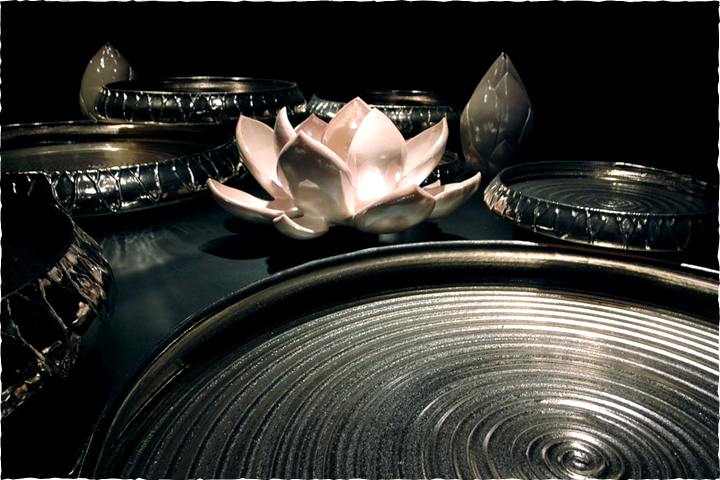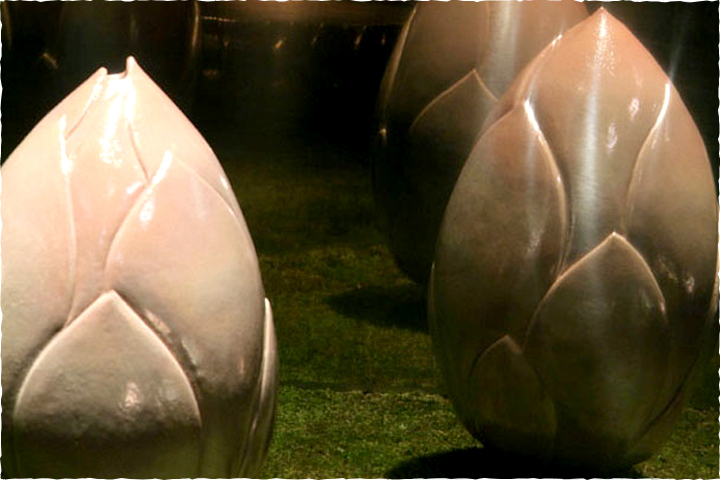

Love Lotus: Homecoming Exhibition
Yasuyuki Ishizaki
Museum of Modern Ceramic Art, Gifu
Hanako Miwa's "Love Lotus" was presented last autumn (September 29 – October 8) as the first exhibition of the Association Japon-Europe pour les Exchanges Culturels (AJEEC) with the cooperation of the Sezon Museum of Modern Contemporary Art in the Grand Hall on level B3 of the Japan Cultural Institute in Paris. The current exhibition, "Hanako Miwa: Love Lotus," is the homecoming version of the Paris exhibition held in Hagi City. Hanako Miwa is the eldest daughter of the twelfth Kyusetsu Miwa (Ryosaku Miwa), the current head of the Miwa Kiln and a well known avant-garde artist. Since her first solo exhibition, "Myō" (Mystery), in 2001, she has made a strong impression as a progressive artist, creating installations with objects made of traditional materials of the Hagi region.
In her first show, she produced tranquil images in black ceramic with a matte finish; in "Love Lotus" she has treated the same motif of lotus flowers and leaves but with the bewitching glow of platinum luster. The artists says that she wanted to "share a love for life and a life force beyond the wall of the self, through which people can energize each other, and express a condition in which new growth can be observed." In her installation in Hagi, she reconstructs a harmonious space, expressing her artistic intentions in concentrated form. In the exhibition space, she combines brilliant and sensual red buds and silver-white leaves resembling the South American waterlily Victoria Amazonica, in which the edges of the large circular leaves stand straight up. One part of the installation suggests a lotus pond filled with dark shadows, a deep abyss from which life has emerged. Another recreates a moment in the gray-lighted landscape the teahouse garden, where the host waits for guests with a sincere heart. In both cases, the artist has brilliantly created a beautiful and delicate space.
The title "Love Lotus" may lead many people to think of the statement of Zhou Dunyi, a Chinese scholar of the Northern Song dynasty, who praised the lotus flower as being "like a noble man." This cultivated scholar wrote of his sincere feelings of love for the lotus. The lotus "grows out of mud yet is clean, cleansed by the pure waters and yet not seductive...its fragrance is milder in the distance...and clean." In China, however, in addition to this clean and proper image, the lotus was also identified as a symbol of the goddess Kichijo (Chinese Jixiang, Sanskrit Lakshmi) and had strongly erotic connotations. It was an allegory of the simple feelings and primal desires of romantic love, an important part of life. Without giving more details, suffice it to say that this is why lotus designs and patterns were used on wedding gifts or bedroom furnishings in ancient China.
"Love Lotus" is an strongly emotional theme that almost brings on a sense of vertigo, but here it is presented ascetically with intelligent formal thinking, causing us to recognize an insistent and pure desire for expression on the part of the artist.
From Tōsetsu (June 2006)
Love Lotus
![]()
![]()
![]()

Photo: Nobuo Shimose
